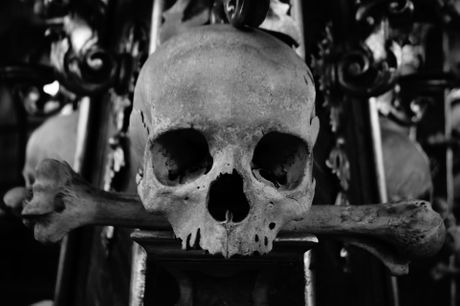Horrifying scene near Zajecar: Three human skulls found on sticks in suspected cult ritual

While exploring remote areas near the village of Prlita, about ten kilometers away from Zajecar, mountaineer Jovan Cvetkovic and his friend on September 13 came across a horrible sight in front of a cave - a human skull and a bone placed on a stick!
They went inside the cave, where they found a pile of human bones.
"Two complete skulls and another fragment of a skull were noticeable in the cave. There were at least three skulls. I don't know about the other bones, I'm a layman, but the skulls were recognizable," says Cvetkovic.
He adds that the remains of a fire showed that someone had recently been in the cave, although it is difficult to reach. A day after he reported the case to the police, Cvetkovic took a forensic team to the site.
"The most bizarre thing is that the skull, and some part of the body, I think the pelvic bone, were put on a stick, which was driven into the ground. Someone was having fun or doing some rituals. Forensic scientists did everything they needed to do, took pictures, placed numbers, picked up the bones into a bag," Cvetkovic explains.
One of the best known Serbian expert for cults, Dimitrije Pastulovic, says that, according to descriptions by eyewitnesses who saw the bones on the stick and according to the photographs, everything indicates that this is a ritual performed by the Quimbanda sect, Kurir writes.
"This is a black magic ritual, it looks like Quimbanda, what they call voodoo magic. It's also possible that the bones were excavated from someone's grave and taken there. If the bones were taken there, that’s what Quimbanda does, it’s raising the dead, necromancy. They act in a similar way, perform similar rituals and invoke the soul of the deceased, making an obligatory sacrifice. It remains to be seen whether any animals or anything similar were found at the site where the human remains were found," he explains.
Dr. Sofija Stefanovic, an archaeologist who has researched skeletal remains from a large number of archeological sites, says that it's important for citizens to report such discoveries to the Institute for the Protection of Cultural Monuments.
A number of skeletons
"Based on the photographs, it can be seen that these are human bones, two central pelvic bones can be seen, they are the remains of at least two individuals. This is not about people being buried, these are not graves, these are scattered bones. Since all soft tissues have already decayed, it's clear that this is something older that would be valuable for the Institute as well. It's not possible to guess which period is in question, tests will show that, but it's obvious that all soft tissues have disintegrated and that cannot happen in less than ten years," said Stefanovic.
The Zajecar police say that they conducted an investigation, collected evidence and handed it over to the Higher Public Prosecutor's Office in Zajecar, which said that they are still collecting information.
Bones older than 100 years old
The mayor of Zajecar, Bosko Nicic, points out that according to what he learned from the police, there was no basis for initiating any further proceedings.
"Forensic scientists have determined that the bones are more than 100 years old and that they are not of major archaeological significance. They assume that they are from the period of the First World War. There are no reports from that period that any crime was committed."
Video: Creepy video from doctors sect: Women dance half-naked, children among sex slaves
(Telegraf.rs)
Video: Poljski novinar se javio za reč posle derbija, postavio pitanje na srpskom i nasmejao trenera
Telegraf.rs zadržava sva prava nad sadržajem. Za preuzimanje sadržaja pogledajte uputstva na stranici Uslovi korišćenja.

